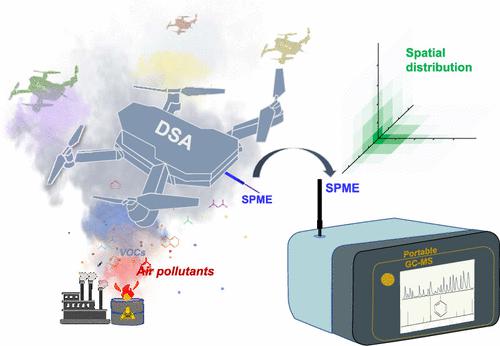当前位置:
X-MOL 学术
›
Environ. Sci. Technol.
›
论文详情
Our official English website, www.x-mol.net, welcomes your feedback! (Note: you will need to create a separate account there.)
Onsite Identification and Spatial Distribution of Air Pollutants Using a Drone-Based Solid-Phase Microextraction Array Coupled with Portable Gas Chromatography-Mass Spectrometry via Continuous-Airflow Sampling
Environmental Science & Technology ( IF 11.4 ) Pub Date : 2022-11-17 , DOI: 10.1021/acs.est.2c05259 Weini Chen 1 , Yingtong Zou 2 , Wenzheng Mo 1 , Dandan Di 1, 3 , Bin Wang 3 , Manman Wu 2, 4 , Zhengxu Huang 1 , Bin Hu 1
Environmental Science & Technology ( IF 11.4 ) Pub Date : 2022-11-17 , DOI: 10.1021/acs.est.2c05259 Weini Chen 1 , Yingtong Zou 2 , Wenzheng Mo 1 , Dandan Di 1, 3 , Bin Wang 3 , Manman Wu 2, 4 , Zhengxu Huang 1 , Bin Hu 1
Affiliation

|
Hazardous air pollutants can be unintentionally and intentionally released in many cases, such as industrial emissions, accidental events, and pesticide application. Under such events, the onsite operation is highly dependent on the molecular composition and spatial distribution of air pollutants in ambient air. However, it is usually difficult for people to reach hazardous and upper sites rapidly. In this work, we designed a new drone-based microextraction sampler array in which a solid-phase microextraction (SPME) fiber was mounted on drones for remote-control sampling at different spaces and was then coupled with a portable gas chromatography-mass spectrometry (PGC-MS) approach for quickly identifying hazardous air pollutants and their spatial distribution in ambient air within minutes. Acceptable analytical performances, including good sensitivity (detection limit at nanogram per liter level), reproducibility (relative standard deviation < 20%, n = 6), analytical speed (single sample within minutes), and excellent linear dynamic response (3 orders of magnitude) were obtained for direct measurement of air samples. The drone–SPME sampling mechanism of air pollutants involving an airflow adsorptive microextraction process was proposed. Overall, this drone–SPME sampling array can access hard-to-reach and dangerous environmental sites and provide air pollution distribution in different spaces, showing versatile potential applications in environmental analysis.
中文翻译:

使用基于无人机的固相微萃取阵列结合便携式气相色谱-质谱法通过连续气流采样对空气污染物进行现场识别和空间分布
在许多情况下,有害空气污染物都可能无意和有意释放,例如工业排放、事故事件和农药使用。在此类事件下,现场操作高度依赖于环境空气中空气污染物的分子组成和空间分布。然而,人们通常很难快速到达危险和高处。在这项工作中,我们设计了一种新的基于无人机的微萃取采样器阵列,其中固相微萃取 (SPME) 纤维安装在无人机上,用于在不同空间进行远程控制采样,然后与便携式气相色谱-质谱联用( PGC-MS) 方法可在几分钟内快速识别有害空气污染物及其在环境空气中的空间分布。可接受的分析性能,n = 6)、分析速度(几分钟内完成单个样品)和出色的线性动态响应(3 个数量级),可直接测量空气样品。提出了涉及气流吸附微萃取过程的空气污染物无人机-SPME 采样机制。总的来说,这种无人机-SPME 采样阵列可以进入难以到达和危险的环境场所,并提供不同空间的空气污染分布,显示出在环境分析中的多种潜在应用。
更新日期:2022-11-17
中文翻译:

使用基于无人机的固相微萃取阵列结合便携式气相色谱-质谱法通过连续气流采样对空气污染物进行现场识别和空间分布
在许多情况下,有害空气污染物都可能无意和有意释放,例如工业排放、事故事件和农药使用。在此类事件下,现场操作高度依赖于环境空气中空气污染物的分子组成和空间分布。然而,人们通常很难快速到达危险和高处。在这项工作中,我们设计了一种新的基于无人机的微萃取采样器阵列,其中固相微萃取 (SPME) 纤维安装在无人机上,用于在不同空间进行远程控制采样,然后与便携式气相色谱-质谱联用( PGC-MS) 方法可在几分钟内快速识别有害空气污染物及其在环境空气中的空间分布。可接受的分析性能,n = 6)、分析速度(几分钟内完成单个样品)和出色的线性动态响应(3 个数量级),可直接测量空气样品。提出了涉及气流吸附微萃取过程的空气污染物无人机-SPME 采样机制。总的来说,这种无人机-SPME 采样阵列可以进入难以到达和危险的环境场所,并提供不同空间的空气污染分布,显示出在环境分析中的多种潜在应用。


























 京公网安备 11010802027423号
京公网安备 11010802027423号